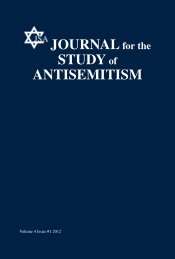JOURNALfor the STUDYof ANTISEMITISM
JOURNALfor the STUDYof ANTISEMITISM
JOURNALfor the STUDYof ANTISEMITISM
You also want an ePaper? Increase the reach of your titles
YUMPU automatically turns print PDFs into web optimized ePapers that Google loves.
234 JOURNAL FOR THE STUDY OF <strong>ANTISEMITISM</strong> [ VOL. 3:225<br />
and became closely associated with Otto Strasser and Goebbels. For a while<br />
he lived in a ménage à trois with Goebbels and his mistress, a young actress<br />
who also happened to be an NKVD agent. 21 Hartner-Hnizdo denounced<br />
Bronnen as a representative of “<strong>the</strong> victory of <strong>the</strong> vanguard of <strong>the</strong> sexual<br />
revolution over <strong>the</strong> German world of order, intellect and morality”—in<br />
o<strong>the</strong>r words, of Bolshevism. This led him to <strong>the</strong> observation that “we<br />
should not overlook <strong>the</strong> fact that <strong>the</strong>re is a remarkable resemblance between<br />
<strong>the</strong> Jewish and <strong>the</strong> Mongol-Tartar temperament as far as <strong>the</strong> libidinal is<br />
concerned. Thus we see in <strong>the</strong> Bolshevik revolution in Russia <strong>the</strong> leadership<br />
divided between <strong>the</strong> Jew Trotsky and <strong>the</strong> Mongol Lenin, who incidentally<br />
has Jewish blood in his veins from his mo<strong>the</strong>r’s side.” 22<br />
Hartner-Hnizdo’s final victim before turning to Hugo Bettauer was<br />
Max Glass, author of Die entfesselte Menschheit (Humanity Unchained), a<br />
novel about <strong>the</strong> revolution in Germany in November 1918. All <strong>the</strong> characters<br />
in <strong>the</strong> book are described as violently aggressive, pathologically criminal,<br />
and determined to free <strong>the</strong>mselves from all moral, cultural, and social<br />
restraints. It was a ferocious condemnation of middle-class attitudes toward<br />
<strong>the</strong> “o<strong>the</strong>r”—<strong>the</strong> “November criminals” who had stabbed <strong>the</strong> fa<strong>the</strong>rland in<br />
<strong>the</strong> back, proletarians, and Jews. Glass’ novel was promptly turned into a<br />
successful film, beginning for him a meteoric career as a screenwriter and<br />
producer. 23 It was for Hartner-Hnizdo a prime example of <strong>the</strong> “hair-splitting<br />
philosophy,” “Talmudic writing,” and “purely economic and libidinal attitude”<br />
typical of his race. Such trumpeting of “lack of prejudice” was a<br />
destructive attitude that posed a serious danger to German civilization.<br />
Hartner-Hnizdo’s condemnation of Die entfesselte Menschheit was warmly<br />
endorsed by <strong>the</strong> prominent racist ideologue Franz Schattenfroh in a book<br />
that suggested that mass murder was <strong>the</strong> optimum solution to <strong>the</strong> Jewish<br />
21. For details of Bronnen’s remarkably checkered career, see Friedbert Aspetsberger,<br />
Arnolt Bronnen, Vienna 1995; Harald Kaas, “Der faschistische Piccolo”<br />
A.B’, in Intellektuelle im Bann des Nationalsozialismus, Karl Corino (ed.),<br />
Hamburg: Hoffmann and Campe, 1980, pp. 136-149.<br />
22. Erotik und Rasse, p. 106.<br />
23. For Die entfesselte Menschheit, see Andy Hahnemann, “ ‘Der Tod jagt<br />
durch die Strassen . . .’ Zur Psychopathologisierung der Revolution” in Max Glass,<br />
Die enfesselter Menschheit (1919), in “Friede, Freiheit, Brot.” Romane zur deutschen<br />
November Revolution, ed. Ulrich Kittstein and Regine Zeller, Amsterdam<br />
2009. Glass founded <strong>the</strong> production companies Terra-Film-Gesellschaft, Max<br />
Glass-Film GmbH, and Kristall-Film GmbH. As a Jew who converted to Catholicism,<br />
he was forced to leave Germany in 1933. After a short but successful career<br />
as a film producer in Paris, he managed to travel to Brazil and <strong>the</strong>n to <strong>the</strong> United<br />
States. He returned to France after <strong>the</strong> war, where he died in 1965. He was <strong>the</strong><br />
stepfa<strong>the</strong>r of <strong>the</strong> psychologist Hans Eysenck. See http://www.lips.org/<br />
bio_GlassM.asp.














